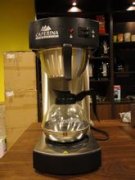The bag brewing method is convenient for brewing coffee.
The advantage of using a filter bag is that it can make a lot of coffee at one time, but it takes a lot of time to brew the filter bag and clean it.

Practice: coffee for three
Warm the brewing coffee, then load a long-mouthed water into the 360c.c. The water is heated to a boil.
Wash the filter bag with warm water and then wring it dry (but not too hard so as not to mess up the cloth eyes), put in 30 grams of coffee powder and gently flatten it, do not press hard, use a spoon to drill a central point on the coffee powder.
When injecting water for the first time, boiled water should be injected slowly from the center of the coffee powder, which expands greatly due to the absorption of water. When one or two drops of water drop from the filter bag, the irrigation should be stopped. The intention is to let the coffee powder soak fully.
After about 20 seconds, slowly inject boiled water from the central point in a spiral, and then inject it from the outside to the inward. It should be noted that the amount of water should be consistent and uninterruptible. At this time, the coffee powder will have a beautiful and meticulous foam and swell.
Do not drop the filtered coffee liquid to the last drop, there is a little boiled water left in the filter paper and can be discarded. If all the drops are finished, there will be miscellaneous smells or impurities, etc.
If the temperature of the filtered coffee is reduced, the coffee can be heated to about 88 degrees Celsius. Be careful not to let the coffee boil.
Note:
The allocation of brewing time and the amount of boiling water should be taken into account.
The new filter bag used for the first time should be boiled in hot water with used coffee powder for five or six minutes before use. The service life of general filter bag is about half a year.
After use, put it into a pot and boil for a while, use high temperature to dissolve the coffee fat, or rinse with lemonade, but never use detergent. Because no matter how the water is washed, the detergent and its taste will remain on the filter bag, affecting the flavor of the coffee.
Coffee fat is more or less attached to the cleaned filter bag, so it is best to soak in water (need to change water every day) or store in the refrigerator to avoid dirt causing cloth clogging and stench caused by coffee fat oxidation.
Important Notice :
前街咖啡 FrontStreet Coffee has moved to new addredd:
FrontStreet Coffee Address: 315,Donghua East Road,GuangZhou
Tel:020 38364473
- Prev

Handmade coffee brewing introduces the common sense of hand brewing coffee.
Professional name: filter type can be divided into filter cup type (filter paper) and filter bag type (filter cloth). Filter cup type: Japanese handmade coffee (Japanese hand brew) is the best. Filter bag type: Italian bag coffee is the best. Professional grinding: Japanese handmade coffee should be ground for 1.52 minutes. Coffee bean quantity comparison table: one person: 1.52 tablespoons for two: 33.5 spoons for three people: 4.55 spoons for four people
- Next

Delicious coffee brewing flannel net brewing coffee
Flannel net brewing can be said to be the original ancestor of coffee bubble brewing method, because it was developed in the 18th century, so the brewing method is very simple, but, unlike filter paper, cleaning and management are very troublesome. After use, you must wash the flannel cloth with hot water and wash it again with clean water to keep it refrigerated. 3 people: deep baked or slightly ground coffee
Related
- Beginners will see the "Coffee pull flower" guide!
- What is the difference between ice blog purified milk and ordinary milk coffee?
- Why is the Philippines the largest producer of crops in Liberia?
- For coffee extraction, should the fine powder be retained?
- How does extracted espresso fill pressed powder? How much strength does it take to press the powder?
- How to make jasmine cold extract coffee? Is the jasmine + latte good?
- Will this little toy really make the coffee taste better? How does Lily Drip affect coffee extraction?
- Will the action of slapping the filter cup also affect coffee extraction?
- What's the difference between powder-to-water ratio and powder-to-liquid ratio?
- What is the Ethiopian local species? What does it have to do with Heirloom native species?

